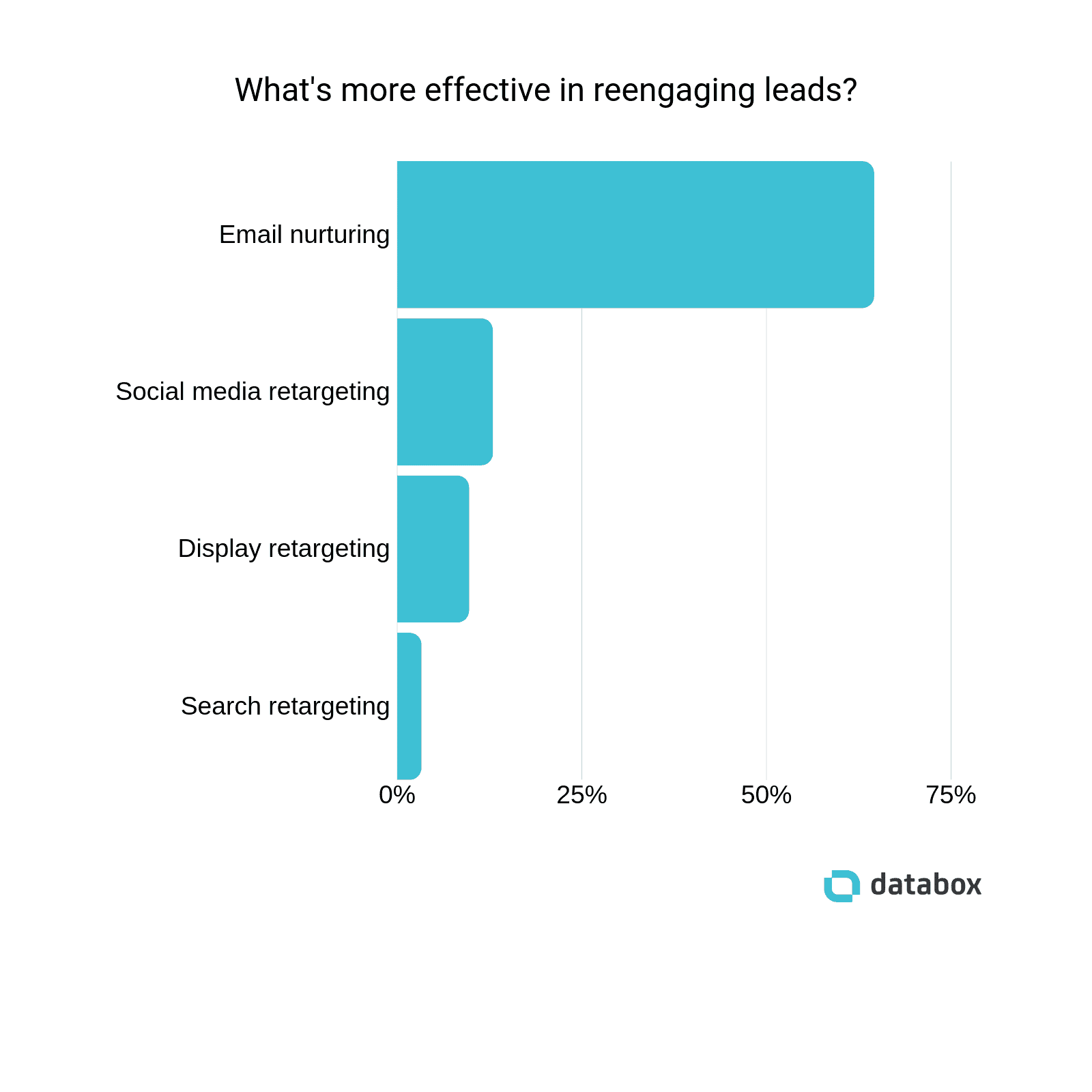Blog
CATEGORY: digital-marketingemail-marketing
Building trust with your leads with an effective email nurture programme

Congratulations, you have caught your prospect’s attention, but now you need to nurture these leads into opportunities for your sales team, as at the moment they are just not ready to buy.
By nurturing your leads you can stay connected and use that connection to build trust and confidence until that point when they are ready to look at buying from you.
To find out what lead nurturing tactics are most effective in 2019, databox asked a group marketers to share the methods they’re currently using to nurture and reengage leads.
Nearly two-thirds of respondents said that email nurturing was the best way to reengage leads:

The mechanics
Your email nurture sequence should be at least 2-3 emails long, at a minimum. But, ultimately it depends on your reader and how long it takes for you to convey all the messages that you want to get across to them.
Now is the time to think about how you can start to get your audience to trust you. Maybe you’ll send them links to your most popular blog post or video content, or maybe you’ll add another little freebie like a checklist along the way. Just make sure that each email in your nurture sequence adds value to the reader’s life.
You can space them out one day apart, or a few days apart, but just don’t have them too far apart as you don’t want your subscribers to forget about you. If you’re worried about people unsubscribing – don’t be. Just make sure that each email is full of value for them.
If they still unsubscribe, then they were never going to buy from you anyway. Harsh, but true.
Keep it relevant
“On average, 95% of email sent is brands talking to consumers rather than personal communication,” says Marcel Becker, director of product management at Verizon Media. “Improving the way brands connect with consumers is the driving force in our continued focus on creating better user experiences in email.”
“The key to email nurturing is to provide super-relevant and super-practical content that delivers real value to your leads on a regular basis,” says Nathan Reiche of Content Chemistry.
“This keeps your business top-of-mind, keeps the lead warm, and gives you a natural opportunity to mention how your product/service can solve problems,” Reiche says.
Agence Nile’s Lydie Deborne recommends “sending leads content that helps them find solutions and progress through the buying journey. The content you send can be an ebook, blog post, or any other type of content you have available.”
“The goal is to provide appropriate content that helps your leads—and not just trying to sell them something,” Deborne says.
Constructing effective copy
That value or usefulness is a key component and one of the Four U’s of Copywriting which is really helpful to keep in mind as you construct your copy. Any copy you produce should be urgent, unique, ultra-specific, and most importantly useful.
While urgency is very important for headlines, if you can’t apply all 4 U’s to your content, urgency is the one to leave out. That’s because uniqueness, usefulness, and ultra-specificity are more important in body of the content than urgency, and also because it can be tricky to maintain urgency throughout the content without sounding too pushy or salesy.
Uniqueness is critical because if visitors have seen similar content or benefits elsewhere, they won’t bother with your content. The uniqueness of your copy includes everything from your writing style to the benefit visitors get from reading your content.
Your copy can be unique, ultra-specific, and urgent without being useful. The uniqueness of your content helps draw readers in, but usefulness is what compels them to keep reading. You must offer a benefit, solve a problem, or otherwise provide value for your audience.
It’s possible for content to be useful without being specific, but the more specific your copy is, the more useful it will be. It’s also possible for content be ultra-specific but not useful. This happens when your content doesn’t match your audience very well or if doesn’t solve a problem your audience has. Specificity is important because it increases how useful the content is and makes it more compelling.
Informing and entertaining content can have a lot of different forms. Think about reports, how to’s, entertaining new, etc. A new trend is that companies are taking the role of knowledge provider. Teaching and using an LMS or Online Course Platform like Learnworlds or Teachable to host videos and a membership site that interacts with your nurturing and lead flows. An intensive amount of contact to increase lead value or recapture CAC (customer acquisition costs).
And automate
When you have mapped out your journey and created your sequence, ensuring that all the information that you wish to impart is covered in a useful, interesting and informative way. Only then should you build. Don't forget to include emails to your team to let you know when leads have reached key points in the flow and also a process to review subsequent activity that your leads take as a result of your mails (building in web-tracking alerts into the process is very useful for this and takes some of the manual effort out)
Once your email nurture sequence is automated, you’ll need to do a full run-through, which means testing everything from opting-in on your website to receiving the full nurture sequence. You need to make sure that everything is automated and that all the automations work.
That’s it!
Solutions
Email marketing healthcheck
We are confident that we can help you, which is why we offer a free healthcheck to identify potential issues with your current programme and free advice on things that could be done to improve it.
![5 benefits of email automation [Infographic]](/assets/blog_images/8-automations-1550852805.jpg)

